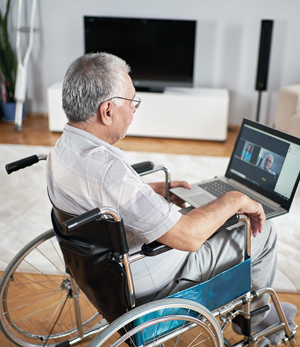Technological innovations are driving improvements in healthcare for at-risk & underserved populations

Imagine a scenario where you live miles away from your cardiologist. You walk into a booth in your hometown and insert your finger into a device that takes your vitals, pulls up your medical history and connects to a vending machine that dispenses your medication right there. “Or, what if your blood pressure is high, and your at-home ‘Dr. Bot’ can let you know and tells you to check it again tomorrow so it can inform your doctor’s office,” suggests HealthTrust Physician Advisor Troy Sybert, M.D., MPH, a preventive medicine physician in Johnson City, Tennessee. “Then, maybe it schedules you for a virtual visit so you can have your meds adjusted.”
Dr. Sybert, founder of HealthyMe LLC, a primary care clinic that offers both in-person and telemedicine visits, not only imagines this scenario, he sees it as an eventual reality. He envisions that the latest healthcare innovations will increasingly rely on telemedicine and artificial intelligence (AI) to help better serve patients—especially rural and at-risk populations.
“Generation Z has grown up with Xbox and virtual reality headsets,” says Dr. Sybert. “If they get a chronic disease, they’re going to want some form of technology to help manage it.”
Technology such as telehealth, AI and remote monitoring are evolving to meet those needs and bring us to a future that, at one time, was only in our imaginations.
Telehealth
Prior to COVID-19, healthcare organizations had been slow to adopt the technology because, historically, it wasn’t covered by insurance. That all changed during the pandemic when people couldn’t physically get in to see their physicians. The Centers for Medicaid & Medicare Services responded to the crisis by widely expanding reimbursement for telehealth. “COVID is the biggest use case example of how reimbursement drives telemedicine as well as other tech adoptions,” says Dr. Sybert.
Although telehealth may seem like it’s essentially video chatting, it is extremely effective when healthcare organizations integrate it as complementary to a regular doctor visit. In a direct contract reimbursement model, a number of payors are developing their own versions of telehealth to help manage chronic illness, work-related illness and urgent care.
Since the rise of freestanding urgent care centers in the last decade, primary care offices now may see more patients for chronic care and prevention. These visits often have predictable health journeys, so telemedicine models can be integrated to make care more efficient and less costly, says Dr. Sybert. The ability to manage chronic conditions from afar also presents a solution for people who live in areas with shortages of healthcare providers, or who have transportation or mobility issues.
Autobots
Anyone who has used the internet in recent years has noticed or even interacted with chatbots, or autobots, on company websites. These little helpers pop up on your screen and ask a question: “Do you need assistance finding something?” Based on your response, the bot helps lead you in the right direction. Humans program these bots to perform automated repetitive functions, and machine learning algorithms respond to customer input with templated responses.
Hospitals and health systems may use chatbots as a screening tool, a solution triggered by the pandemic. With stay-at-home orders in place, visits to hospitals and clinics declined. Healthcare organizations were caught off guard with how to interface with patients in this type of environment. “There was so much going on, much of which was remote, so chatbots were brought to market to run a series of triage questions for COVID symptoms,” explains Dr. Sybert.
He believes companies will continue to develop more algorithms to use bots in healthcare scenarios. Still, in the clinical world, people are cautious. “What happens if a chatbot guides a patient in the wrong direction?” Dr. Sybert asks. These types of concerns will continue to drive how bots are implemented and customized for healthcare settings.
Remote patient monitoring
Remote monitoring provides a major opportunity to automate care for at-risk populations with chronic conditions, including depression, addiction, hypertension, heart disease and many more—especially for those who have limited or no access to physicians.
“Let’s say my dad has a pacemaker,” offers Dr. Sybert. “He sets a device down by his bedside. As he sleeps, the device automatically connects to a system where information is pumped in and shared with the company that monitors him remotely on behalf of the physician’s office.”
For a patient who lives hundreds of miles from a cardiologist or who is at high-risk for a health event, the benefits are clear. Physicians can obtain a real-time picture of the patient’s health and make immediate adjustments to medications and care plans without the patient having to physically come into an office.
Still, ease-of-use is a key factor in patient adoption. “If it’s too complicated to set up or use, the patient will just forget it,” says Dr. Sybert.
Artificial intelligence

There is a significant opportunity to use AI in healthcare to drive better access to treatment, especially when geography and poverty are barriers. AI uses neural networks, a type of machine learning inspired by the human brain, to mimic how biological neurons signal each other to drive outcomes.
AI technology will help us reach vulnerable and at-risk patients with limited access to care. In less resource-rich areas of the world, a primary care doctor or radiologist may not be available to read a mammogram. “To have an AI that could reliably read a mammogram without needing to access a radiologist would be huge,” says Dr. Sybert.
AI takes a hefty investment upfront, but once it’s developed it can be highly cost effective. “We don’t have enough radiologists in the world to do this, so why not take AI that can detect breast cancer in mammograms and open healthcare access to patients all over the world?” he asks.
Physicians leading the way
Dr. Sybert encourages physicians to be diligent about understanding technology and to be part of the process in developing it for future use. As baby boomers retire, we will see increased adoption of these technologies more quickly by younger generations, he suggests. “It’s disruptive to physicians to have to learn a new system,” Dr. Sybert acknowledges. “But that’s not patient-centric. These technologies are completely disrupting care for the benefit of patients, which may not always be for the convenience of the doctor. Don’t shy away from it—learn about it, lead it and help shape it.”
Share Email AI, Innovation Center, Q4 2021, Social Determinants of Health, Telehealth





